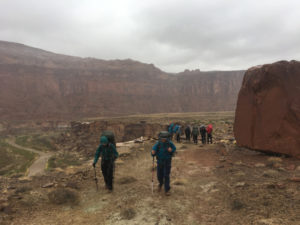 Rain in the desert is magical. The sky turns dark and fog settles into the canyons. Moments after the first raindrop, the sagebrush alerts our noses to the water by releasing a pungent odor. The pitter-patter of rain hitting the soil creates little dimples that give way to rivulets and then streams. The cacti grow roots, as quickly as the lightning flashes across the sky, to absorb the precious resource, and mosses turn green, photosynthesizing once again. Several minutes later, the rocks are iridescent, and our boots are encased in colorful layers of mud.
Rain in the desert is magical. The sky turns dark and fog settles into the canyons. Moments after the first raindrop, the sagebrush alerts our noses to the water by releasing a pungent odor. The pitter-patter of rain hitting the soil creates little dimples that give way to rivulets and then streams. The cacti grow roots, as quickly as the lightning flashes across the sky, to absorb the precious resource, and mosses turn green, photosynthesizing once again. Several minutes later, the rocks are iridescent, and our boots are encased in colorful layers of mud.
But rain in the desert is rare. In the past five weeks, it has rained three times, and we’ve been told that snowpack is 65% lower than average in some areas. This already dry region is facing another year of the 20-and-counting-year drought. During our past two weeks on the Hopi and Navajo Nations, we have learned that the indigenous people who live in this area rely on water from rain, melting snow, and springs to support wild plants, provide drinking water, and provide moisture for their crops. The recurring statement from our hosts has been, “Everything we do is for rain.”
One morning in the Hopi Nation, we met a Hopi runner named Bucky. Sitting on his blanket-covered couch, we listened to Bucky recount his days as a young child, running age-old trails between his village, his family’s fields, and the shrines and springs in the area. This running held cultural significance; the paths the Hopi ran were seen by the Cloud People, and “when the Cloud People see you on the trails, they’ll bring rain.” When Bucky returned to the Hopi Nation after boarding school, he found many of the old paths gone or forgotten. The tradition of running for rain was being lost. Bucky began running the trails again and began an annual “Water is Life” ultra-marathon across the Hopi Nation. “It’s not a race. It’s about prayer” and keeping the Hopi tradition of running for water alive, explains Bucky. As Westerners, we may not see running as a religious activity, but for the Hopi, running brings rain, a necessity for life.
Later that afternoon, we drove west from the Hopi Nation to the Navajo Nation, where our hosts invited us to participate in the rituals associated with upkeeping their sweat lodge, which were also focused on rain. After cleaning the inside and building a platform at the entrance, we began to mix water and soil to replaster the exterior. As we finished the task, a small amount of mud remained in the wheelbarrow. Our host grasped a handful with his already-muddy hands and encouraged us to mold the mud into figurines while praying for rain. The frog I made sits atop a slab of slickrock near the sweat lodge, waiting for rain to fall on the valley below. It will remain as a call to water until it is washed back into the earth.
The final rain ritual for the sweat lodge involved covering the top with water. The ten of us held our water bottles and surround the earthen structure. We took a drink and sprayed the water from our mouths onto the newly finished sweat lodge. Then we emptied the remaining water in our bottles onto the structure and walked a full circle around it, again praying for rain. The labor we put into improving and maintaining the sweat lodge was more than labor; it was a call for rain.
From these two experiences, as well as other stories and experiences of singing, dancing, praying, and watching the skies while on the Hopi and Navajo Nations, I have come to appreciate the importance of rain for the indigenous people on the Colorado Plateau. The first times I saw it rain on this landscape, I found it beautiful, but inconvenient. I had to don my raingear and suffer heavy, muddy boots. But after seeing how rain is the livelihood of the people who live here, next time it rains in the desert, I’ll appreciate its value and beauty over the inconvenience. When it starts to sprinkle, I’ll raise my hands to the sky and sing and dance. I will draw in the clouds and ask the skies to continue to bring this landscape to life.